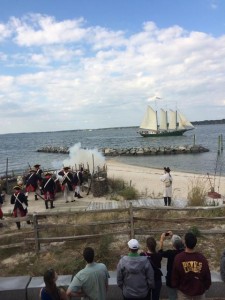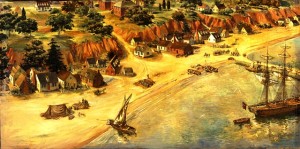{UPDATE}
 We received the report outlining the results of our York River assessment from the Virginia Department of Recreation and Conservation (DCR). As we expected, the York River qualified for designation as a scenic and historic state river. The next step was to go back to the Boards of Supervisors of York County and Gloucester County and provide them feedback, answer questions, and outline the next steps forward. After receiving comments and discussion, each County Board voted to move forward in their own chambers on 1 December 2015. In those meetings, each county reviewed and approved a resolution to support designation of the 20-mile segment of the York River bordering York and Gloucester counties as a state scenic river. This 20-mile segment will run from the upriver York County Line directly across the river to the Gloucester County side. From this upriver line, the designated area extends all the way downriver to Gloucester and York County lines at the mouth of the river.
We received the report outlining the results of our York River assessment from the Virginia Department of Recreation and Conservation (DCR). As we expected, the York River qualified for designation as a scenic and historic state river. The next step was to go back to the Boards of Supervisors of York County and Gloucester County and provide them feedback, answer questions, and outline the next steps forward. After receiving comments and discussion, each County Board voted to move forward in their own chambers on 1 December 2015. In those meetings, each county reviewed and approved a resolution to support designation of the 20-mile segment of the York River bordering York and Gloucester counties as a state scenic river. This 20-mile segment will run from the upriver York County Line directly across the river to the Gloucester County side. From this upriver line, the designated area extends all the way downriver to Gloucester and York County lines at the mouth of the river.
But, there is one more step to take. To become an officially designated scenic or historic River, a Bill must be introduced into the Virginia Assembly and passed. The Watermen’s Museum and the two County Boards are working together with the appropriate Virginia Assembly members to make this a reality in the upcoming session.
 [Original News Post, Aug 15, 2015] Did you know that the York River, the home waters of the Powatan Confederation, location of America’s busiest early colonial port, site of the last major battle of the American Revolution, occupied port during the ‘War of Northern Aggression,’ and seafood breadbasket for the people who have lived along her shores, has not been officially declared scenic or historic? Well, we’re doing something about that. And, the first major step occurred Monday, July 13, 2015.
[Original News Post, Aug 15, 2015] Did you know that the York River, the home waters of the Powatan Confederation, location of America’s busiest early colonial port, site of the last major battle of the American Revolution, occupied port during the ‘War of Northern Aggression,’ and seafood breadbasket for the people who have lived along her shores, has not been officially declared scenic or historic? Well, we’re doing something about that. And, the first major step occurred Monday, July 13, 2015.
Working with the Virginia Department of Conservation and Recreation (DCR, for short) we conducted a survey of the York River from the mouth of the river to roughly 20 miles upriver. To give you some background, the Virginia Scenic Rivers Program’s intent is to identify, designate and help protect rivers and streams that possess outstanding scenic, recreational, historic and natural characteristics of statewide significance for future generations. This program is managed by the state and should not be confused with the federal Department of the Interior’s Wild and Scenic Rivers Program. One of the program’s strengths is the partnership forged between citizens, local governments and the state. This partnership begins in the evaluation phase and continues through and after the designation process.
In 2013, the Watermen’s Museum contacted DCR personnel to find out more about the program. From that initial research and conversations, we formed a committee of regional community partners, ranging from private and public organizations and government agencies that occupy York River shoreline to interested non-profit, educational, and tourism, organizations. We developed briefings, coordinated and conducted public meetings, and met with county and city boards surrounding the river. From that effort, we received the support of both York County and Gloucester County to move forward on the first step of the process…conducting a survey to see if the York River meets the criteria for moving forward. (We believe it does. But, we need to go through the formal process.)
So, a skiff (provided by Patriot Tours and Provisions) and the sailing Schooner Serenity (provided by Yorktown Sailing Charters) traveled the river with staff from DCR to do the initial survey that began the formal evaluation phase of the program. The survey covered a full-day, leaving Watermen’s Museum at 8 AM, sailing up one shoreline and back down the other. All along the way, DCR observed, documented and evaluated the River’s attributes against the formal checklist.
So, what impact will this designation have on the York River, and the people that live along it or work upon it? Here are the benefits:
- Provides opportunities to consider scenic and other resources in planning and design.
- Focuses Federal Energy Regulation Commission (FERC) reviews of hydro or related project proposals.
- Encourages closer review of projects and proposals by state agencies and localities.
- Requires General Assembly authorization for dams.
- Provides for continued existing appropriate riparian land uses by landowners.
- Allows for project review and monitoring of designated river segments by governor-appointed Board of Conservation and Recreation and DCR.
- Provides framework for appointment of a local Scenic River Advisory Committee.
Provides eligibility for land use tax considerations, if locally adopted.
Download What the Designation Does and Does Not Do (PDF) for more detail.
So, in summary, the scenic and historic designations do nothing to stop landowners’ use of their residential or commercial properties. They do not prevent any fishing our other seafood harvesting operations from occurring in waters that are not protected by other regulations or rules. They do make funding more available for tourism, boat landings, and other uses of the state-owned waters. Getting these designations is like getting the “Good Housekeeping” golden seal of approval. It opens potential funding sources to help us make our waters more accessible for recreation and tourism.

